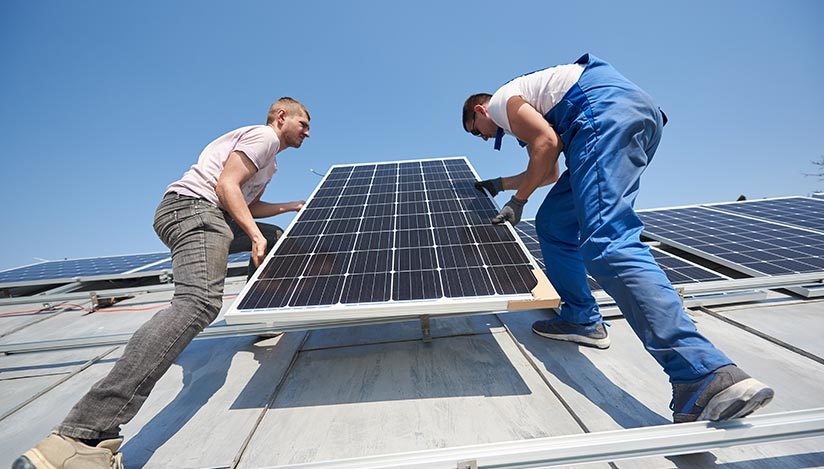Is DIY Solar right for your home?
Solar power is becoming ever more popular as homeowners recognize the financial benefits of going solar. There’s no lack of professional installers to choose from, but homeowners who are a little handier than the average person are often interested in taking the DIY approach to building and installing a solar power system and saving a little money.
There’s plenty of information available online on the basics of mounting panels to a roof. You can buy all the equipment you need for a system piecemeal, or buy a complete DIY solar kit. And not only that, if you’re willing to trade some efficiency for cost, you can buy used or even slightly damaged equipment from resellers.
For people who are committed to DIY solar, there are plenty of options. But are they right for you and your home?
What are you using your DIY solar system for?
Before you start working on a DIY solar system for your home or property, you need to establish what you’re intending to use it for. This will determine the overall size of the system you’re going to install, how many solar panels you need, and what hardware you need to support them.
Most DIY solar systems are better suited for smaller-scale, off-the-grid setups. Powering an RV, or a tiny house are reasonable goals for off-grid DIY solar. If your energy needs aren’t particularly demanding, then a small DIY system can be more than enough. But if you’re thinking about powering a suburban home, you are going to need something that is much larger and scale.
The average US home consumes about 900 kWh of electricity each month, though your usage will vary depending on your household, where you live, and what time of year it is. A small DIY system isn’t going to power a typical suburban home, and it might not even provide enough electricity to put much of a dent in your monthly energy bill. Basically, if you look at your electricity consumption on a month to month basis, you can establish a baseline for what sort of DIY system you need and want.
Do you know if your roof is right for solar?
Chances are, you’re planning on mounting solar panels on your roof. It doesn’t take up backyard space, and ideally, it’s in direct sunlight for most of a day. But before you start climbing all over your roof, you should probably find out if your roof is suitable to mount anything on.
Roof-mounted solar systems are affected by different aspects of a roof. The material used, the pitch of the roof, its size and shape, the orientation of the home, and even the amount of shade you can expect throughout the day.
Also bear in mind that you’re going to have to hire a licensed electrician or a structural engineer—or possibly both—to examine your home and the roof. It may well be that your existing wiring isn’t up to code, and any work which modifies it will require that all your wiring be brought up to code.
Roofing materials:
Most roofing materials are compatible with solar panels. Asphalt shingles are the most popular roofing material in modern homes today, and they are also among the most compatible with solar panels. They can accept any mounting racks for solar panels, and whatever is needed to fasten them in place. Metal and tile roofs are also a good fit for most rooftop solar systems.
But if your home has a wood shingle or slate roof, you might be in for some trouble. These materials are comparatively brittle next to other roof materials. There’s a good chance you can damage the roof just walking around on top of your home, not to mention the rest of the work to install the panels, mounting racks, inverters, and wiring necessary for the system. Wooden shingles also represent a fire hazard, so you will have to do extra work to ensure that any solar system you mount on this type of roof remains safe!
Pitch and orientation:
Regardless of where you place your solar panels, the goal to ensure that the are in direct sunlight for as much of the day as possible. To that end, the orientation of your home relative to the sun and the pitch of your roof are both extremely important.
Depending on how your home faces the sun over the course of the day, there are optimal locations for roof-mounted solar panels. You will want to determine this before you start installing mounting racks and panels. Here in the northern hemisphere, you want your panels facing towards the south.
You also want to determine the angle of your installation point. In general, roof angles between 30 and 45 degrees, with a good orientation, will allow your solar panels the most time to collect sun and generate electricity. Some experts believe you want to avoid anything over 40 degrees, as steeper angles reduce efficiency.
Where things get extra complicated is if your roof consists of extremely steep angles. To get the best efficiencies, you will need to install racks elevate the panels off the roof surface in order to get the correct angles for your panels, or you may have to consider alternative installation options, such as a ground-mounted solar power system.
Shading:
The orientation of your home may have your rooftop solar panels shaded throughout certain parts of the day. The cause for shade may be completely out of your control, such as tall neighborhood trees or taller buildings. One part of your roof may be forced into the shade before others, and depending on where you install your panels, it means that some panels will be working longer and more efficiently than others.
If your home is heavily shaded throughout peak production hours, unfortunately there’s just not a whole lot you can do. Rooftop panels may not be the best solution for you. But there may be other parts of your property that are not affected by shade and suitable for installing a solar system.
The size of your roof:
If your intent is to install a DIY system that is fit for the average energy use of a home today, you’re looking at a 5-kilowatt system, which is the average size of solar system in use today. To install solar panels that can generate this among of electricity, you will need about 300 square feet of space on your roof.
This isn’t set in stone because you can choose either monocrystalline, polycrystalline, or thin-film/photovoltaic solar panels for your DIY system. Each of these material types has different power generation efficiencies, which means that you might need more, or less, square footage of these panels per kilowatt. If your roof can’t accommodate all of the solar panels you need, you might need to supplement the roof panels you can install with ground-mounted solar panels.
Rooftop condition:
Unless you are a professional roofer and know what to look for, you should consider hiring a professional to inspect your rooftop. Nobody wants to discover serious problems with their roof after starting to install a solar system.
If serious problems are discovered with your roof, repairs must be made if you’re intent on a roof-mounted solar system.
My roof is perfect for solar! Now what?
Once you know that your roof is ready for a solar system, you’ll need to get the necessary equipment.
Asphalt shingle roofs allow for easier installation of standard penetrating mounts. But if you have a tile roof, you might have some extra work on your hands with removing and cutting tiles to accommodate the mounts and wiring. You should try to make sure you have all the tools you’re going to use to get the equipment on the roof.
You should also make sure that your DIY solar kit is complete, as sometimes these kits don’t actually include everything you need, such as wiring, inverters to convert direct current (DC) to alternating current (AC), and a storage battery (if desired).
But before you buy anything, draw up a plan of how large your system is going to be, and exactly what you are going to install. Then, you’ll have to submit applications to your city or counting building department, and a local utility company. If you don’t know how to draft a permit application, you’ll need to hire a contractor or other professional to do it for you.
Why buying used or old solar panels and equipment isn’t the best option
One way some DIY solar installers try to save money is by buying older equipment, including old solar panels, previously used inverters, and other refurbished solar equipment.
While this can save you money in the short term, it could affect the efficiency of your new system. For example, we’ve discussed in detail how solar panels degrade over time. Panels that have been in use for years have already experienced some wear and tear, and cheaper panels may have significantly reduced performance even after only a few years of use.
If used and refurbished equipment is where you’re going to try and save some money, make sure you can get a warranty. If you’re buying solar equipment secondhand, you might not have the same guarantee of performance and longevity of newer products.
If you’re going to connect your new DIY system to the grid, you’ll still need to call in a professional.
Even after you’ve installed everything you need for your DIY solar system, you will still need the help of a professional to get everything connected to your house. Unsurprisingly, a lot of DIY installers still end up calling electricians to wire the system to their home, and inspect everything to ensure that the system is safe for use.
If your home is connected to an electrical grid, you’re definitely going to have to call your local building department again. This is because utility providers will not allow a solar power system to be interconnected to grid and activated without having the electrical work signed off by the building department. Once the building department gives the okay, then your local utility will finalize the interconnection, and you can finally start enjoying the benefits of solar power.
There’s no denying that DIY solar can and does save people some money. But it can also cost you more money than it would to have a professional do the work if you make a mistake. In particular, failing to secure the proper permitting can be extremely costly, and may result in you having to hire a professional to redo your work.
On the other hand, by hiring a professional solar contractor for the installation, the work is warrantied, and your system will be properly optimized by a professional to ensure the best possible efficiency.
If you want to make sure you get the most out of solar power, there’s nothing that beats getting trained and experienced solar installers out to your property to get it done right, and quickly. If you’re interested in solar for your home, but aren’t sure what kind of system you need, contact Capital City Solar today!

